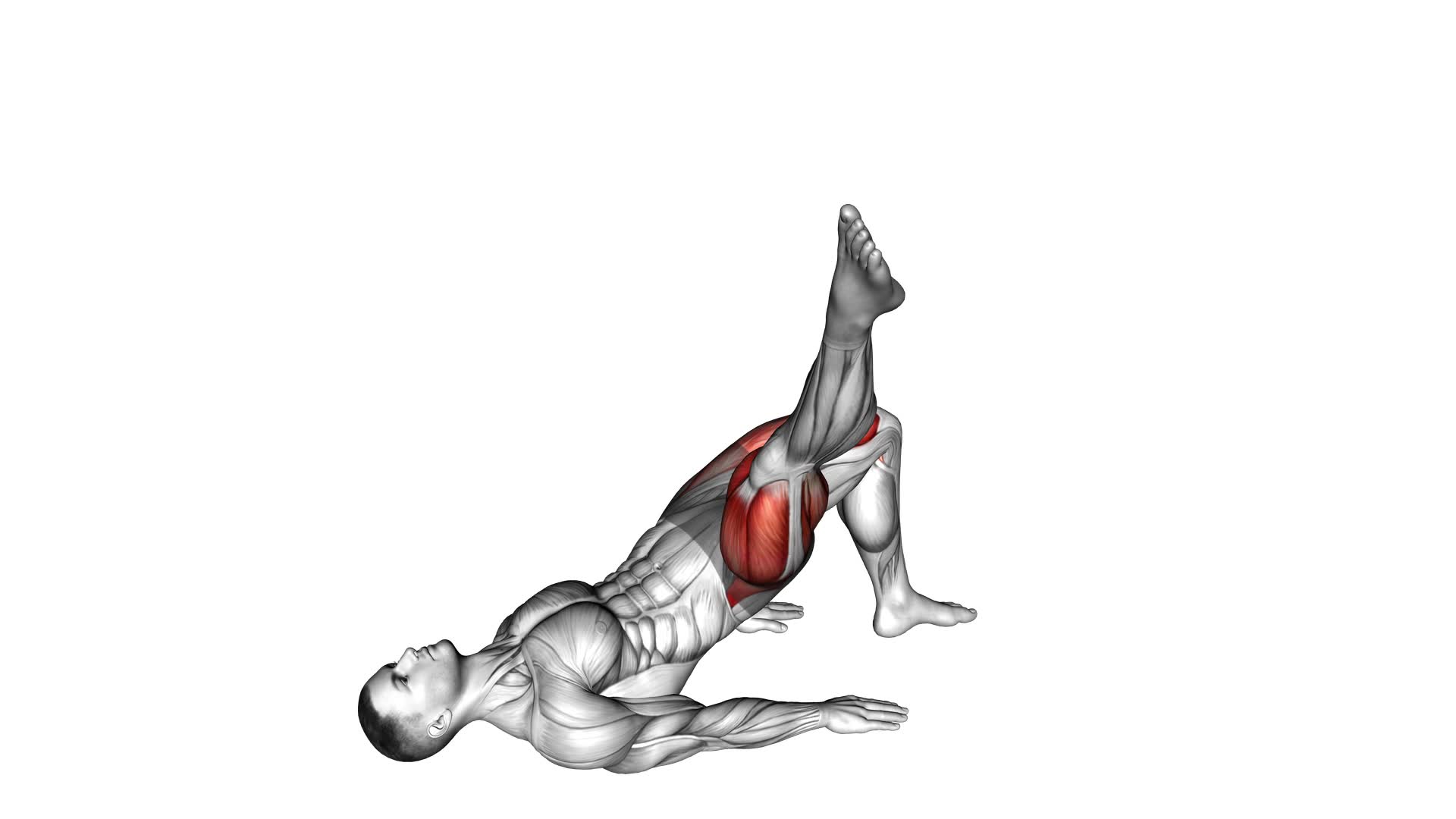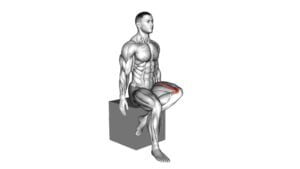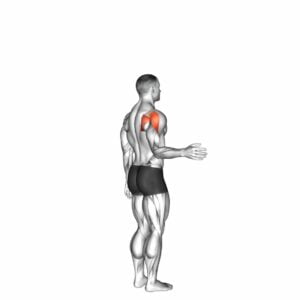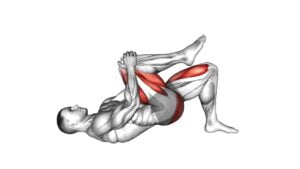Single Leg Glute Bridge With External Rotation – Video Exercise Guide & Tips

In this video exercise guide, you'll learn the proper form and technique for the Single Leg Glute Bridge with External Rotation. This exercise targets your glutes and helps improve hip stability.
Watch This Exercise Video
All you need is a mat or a comfortable surface to perform this effective move. Avoid common mistakes and maximize your results with variations and progressions.
Watch the video and follow the tips to maximize your results and prevent injury.
Let's get started!
Key Takeaways
- The single leg glute bridge targets the gluteus maximus, enhances power and stability, improves hip alignment, and engages core muscles.
- The exercise can be performed with equipment such as a yoga mat, towel, or resistance band.
- Proper form and technique, including hip alignment and squeezing the glutes, are crucial for maximizing benefits and avoiding lower back strain.
- Engaging core muscles, maintaining a neutral spine position, and performing the exercise with a slow and controlled tempo can help prevent lower back strain.
Benefits of the Single Leg Glute Bridge
You can achieve stronger glutes by incorporating the single leg glute bridge into your workout routine. This exercise offers numerous benefits that can help improve your overall strength and hip alignment.
One of the main benefits of the single leg glute bridge is that it targets the gluteus maximus, which is the largest muscle in the buttocks. By strengthening this muscle, you can enhance your overall power and stability during various movements, such as running, jumping, and squatting.
Additionally, the single leg glute bridge can help improve hip alignment. Weak glutes can often lead to poor hip alignment, which can result in various issues like lower back pain and knee problems. By regularly performing this exercise, you can strengthen your glutes and promote better hip alignment, reducing the risk of injury and improving your overall posture.
Furthermore, the single leg glute bridge also engages the core muscles, including the abdominals and lower back. This can help improve your core stability and enhance your overall balance during different activities.
Incorporating the single leg glute bridge into your workout routine can provide you with numerous benefits, including stronger glutes, improved hip alignment, and enhanced core stability. Make sure to perform this exercise correctly and gradually increase the intensity to maximize its effectiveness.
Equipment Needed for the Exercise
To perform the single leg glute bridge with external rotation, you'll need some exercise equipment. The required equipment includes:
- A yoga mat or exercise mat for comfort and stability.
- If you don't have access to these mats, you can also use a towel or a soft surface as an alternative.
Required Exercise Equipment
To perform the Single Leg Glute Bridge With External Rotation exercise, you'll need a resistance band. This equipment is essential to add resistance and challenge your glutes during the exercise.
A resistance band is a versatile and affordable tool that can be easily incorporated into your home workout routine. It provides a convenient option for those who prefer exercising at home and don't have access to a gym or other exercise equipment.
Additionally, using a resistance band allows you to perform alternative exercises that target the glutes effectively. By incorporating this simple piece of equipment into your workout routine, you can enhance the effectiveness of the Single Leg Glute Bridge With External Rotation exercise and achieve better results.
Minimal Equipment Alternatives?
To perform the Single Leg Glute Bridge With External Rotation exercise without a resistance band, alternative equipment options are available. If you don't have a resistance band, don't worry! You can still target your glutes effectively.
One alternative exercise is the Single Leg Glute Bridge with Bodyweight. This exercise requires no equipment and focuses on strengthening your glutes by using only your bodyweight.
To perform this exercise, lie on your back with your knees bent and feet flat on the ground. Lift one leg off the ground and drive your heel into the floor to lift your hips up. Pause at the top and squeeze your glutes before slowly lowering back down.
Now, let's move on to the next section and discuss the proper form and technique for this exercise.
Proper Form and Technique
To perform the single leg glute bridge with external rotation exercise properly, it's important to focus on hip alignment. By keeping your hips level throughout the movement, you can ensure that you're targeting the right muscles and maximizing the benefits of the exercise.
Engage your glute muscles by squeezing them at the top of the bridge, and be mindful of avoiding any strain on your lower back by maintaining a neutral spine position.
Hip Alignment Importance
Ensure proper hip alignment during the single leg glute bridge exercise by activating your glutes and maintaining a neutral pelvic position. This is crucial for hip stability and effective glute activation. Proper hip alignment allows for optimal muscle activation, preventing compensations and reducing the risk of injury.
Here are three reasons why hip alignment is important:
- Improved performance: When your hips are properly aligned, your glutes can work efficiently, leading to greater power and strength during exercises such as the single leg glute bridge.
- Injury prevention: Correct hip alignment reduces stress on the surrounding joints and ligaments, minimizing the risk of strains or sprains.
- Enhanced posture: Proper hip alignment helps to align your spine and maintain a neutral pelvic position, promoting good posture and reducing the risk of lower back pain.
Engaging Glute Muscles
Maintain proper hip alignment throughout the single leg glute bridge exercise to effectively engage your glute muscles and maximize your results.
Glute activation is crucial for muscle engagement and overall strength development. To ensure proper glute activation, focus on driving your hips upward while keeping your core engaged and your back straight.
As you lift your hips off the ground, squeeze your glutes and hold for a moment at the top before slowly lowering back down.
This exercise targets the gluteus maximus, medius, and minimus, helping to strengthen and tone your entire gluteal region.
Avoiding Lower Back Strain
Proper form and technique are essential for avoiding lower back strain during the single leg glute bridge exercise. To ensure you perform the exercise correctly and prevent injury, follow these tips:
- Engage your core muscles throughout the movement to provide stability and support for your lower back.
- Keep your spine in a neutral position by avoiding excessive arching or rounding.
- Maintain a slow and controlled tempo to avoid any jerking or sudden movements that could strain your lower back.
By practicing proper form and technique, you can reap the benefits of stretching and prevent muscle imbalances. Stretching helps increase flexibility and range of motion, reducing the risk of muscle strains and imbalances that could contribute to lower back strain.
Common Mistakes to Avoid
One common mistake to avoid when performing the Single Leg Glute Bridge With External Rotation exercise isn't keeping your supporting foot firmly planted on the ground. This exercise is designed to target your glute muscles and improve hip stability, but if you don't maintain a strong foundation, you may not reap the full benefits.
Proper technique is essential for this exercise. To begin, lie on your back with your knees bent and feet flat on the ground. Extend one leg straight out in front of you, keeping it in line with your hip. As you lift your hips off the ground, make sure your supporting foot stays firmly planted. This will help to engage your glutes and stabilize your pelvis.
Another common mistake isn't maintaining a neutral spine. Avoid arching your lower back or tucking your pelvis under. Instead, focus on keeping your spine in a straight line from your head to your tailbone. Engage your core muscles to help maintain this alignment.
Lastly, be mindful of the speed and control of your movements. Avoid rushing through the exercise and instead, focus on a slow and controlled tempo. This will ensure that you're effectively targeting your glutes and minimizing the risk of injury.
Variations and Progressions
To continue building on your glute strength and hip stability, explore various variations and progressions of the Single Leg Glute Bridge With External Rotation exercise. By incorporating these variations and progressions into your routine, you can challenge your muscles in new ways and continue to make progress towards your fitness goals.
Here are three variations and progressions to consider:
- Elevated Single Leg Glute Bridge: Place your foot on an elevated surface, such as a step or bench, while performing the exercise. This increases the range of motion and adds an extra challenge to your glutes and hamstrings.
- Weighted Single Leg Glute Bridge: Hold a dumbbell or kettlebell on your hips while performing the exercise. The added resistance increases the intensity and helps to further strengthen your glute muscles.
- Single Leg Glute Bridge with Knee Drive: After lifting your hips off the ground, bring your knee towards your chest, engaging your core and hip flexors. This variation adds a dynamic element to the exercise and enhances your balance and stability.
Incorporating these variations and progressions into your workout routine won't only keep your exercises exciting and engaging but also help you continue to challenge your glutes and improve your overall strength and stability. Remember to start with the basic Single Leg Glute Bridge With External Rotation exercise and gradually progress to these variations as you become more comfortable and stronger.
Tips for Maximizing Results and Preventing Injury
To maximize your results and prevent injury, it's important to incorporate proper form and technique into your Single Leg Glute Bridge With External Rotation exercise. By following these tips, you can ensure that you're getting the most out of your workout while minimizing the risk of injury.
First and foremost, it's crucial to maintain a neutral spine throughout the movement. This means keeping your back straight and avoiding any excessive arching or rounding. Engage your core muscles to support your spine and prevent strain.
Secondly, focus on activating your glutes and hamstrings during the exercise. Squeeze your glutes at the top of the movement and lower down with control. This will help to maximize the muscle recruitment and strengthen these areas effectively.
Additionally, pay attention to your foot placement. Keep your foot aligned with your knee and hip to maintain proper alignment and avoid unnecessary stress on your joints.
Lastly, start with a weight that challenges you but allows you to maintain proper form. Gradually increase the weight as you become stronger and more comfortable with the exercise.
Frequently Asked Questions
How Many Reps and Sets Should I Do for the Single Leg Glute Bridge With External Rotation?
For the single leg glute bridge with external rotation, you should aim to do 3 sets of 10-12 reps on each leg.
This exercise targets your glutes and hip muscles, helping to improve stability and strength.
By incorporating external rotation, you also engage the muscles on the outer part of your hips.
To challenge yourself, you can try adding resistance bands or holding a weight on your hips.
Remember to maintain proper form and breathe throughout the exercise.
Can I Do This Exercise if I Have Knee or Hip Issues?
Yes, you can still do this exercise even if you have knee or hip issues. However, it's important to modify the single leg glute bridge with external rotation to suit your needs.
You can try using a lower range of motion or using a resistance band for added support. Alternatively, there are other exercises that target the glutes without straining the knees or hips, such as hip thrusts or clamshells.
Make sure to consult with a healthcare professional for personalized advice.
Is It Necessary to Use a Resistance Band for the External Rotation?
To answer your question, using a resistance band for the external rotation in the single leg glute bridge isn't necessary. However, it can provide added resistance and challenge, helping to strengthen your glutes even more.
If you don't have a resistance band, don't worry! There are alternative exercises and variations available for different fitness levels that can still target your glutes effectively.
Can I Perform This Exercise on a Stability Ball Instead of the Floor?
Yes, you can perform this exercise on a stability ball instead of the floor. Stability ball variations can add an extra challenge to your workout routine by engaging your core muscles.
The instability of the ball requires you to work harder to maintain balance and stability. This can lead to improved core strength, stability, and overall body control.
Incorporating stability ball exercises into your routine can help enhance your overall fitness and performance.
How Often Should I Incorporate the Single Leg Glute Bridge With External Rotation Into My Workout Routine?
To maximize the benefits of incorporating single leg exercises into your routine, it's important to perform the single leg glute bridge with external rotation regularly. Aim to include it in your workout routine at least 2-3 times a week.
As you progress and become more advanced, you can increase the difficulty by adding resistance, such as using a resistance band or holding a weight on your hips. This will challenge your glute muscles even more, leading to greater strength and stability.
Conclusion
In conclusion, the single leg glute bridge with external rotation is an effective exercise for targeting and strengthening the glute muscles. By properly performing this exercise with the correct form and technique, individuals can maximize their results and prevent injuries.
It's important to avoid common mistakes and gradually progress to variations to challenge the muscles further. Incorporating this exercise into a regular workout routine can lead to improved glute strength and overall fitness.

Author
Years ago, the spark of my life’s passion ignited in my mind the moment I stepped into the local gym for the first time. The inaugural bead of perspiration, the initial endeavor, the very first surge of endorphins, and a sense of pride that washed over me post-workout marked the beginning of my deep-seated interest in strength sports, fitness, and sports nutrition. This very curiosity blossomed rapidly into a profound fascination, propelling me to earn a Master’s degree in Physical Education from the Academy of Physical Education in Krakow, followed by a Sports Manager diploma from the Jagiellonian University. My journey of growth led me to gain more specialized qualifications, such as being a certified personal trainer with a focus on sports dietetics, a lifeguard, and an instructor for wellness and corrective gymnastics. Theoretical knowledge paired seamlessly with practical experience, reinforcing my belief that the transformation of individuals under my guidance was also a reflection of my personal growth. This belief holds true even today. Each day, I strive to push the boundaries and explore new realms. These realms gently elevate me to greater heights. The unique combination of passion for my field and the continuous quest for growth fuels my drive to break new ground.







